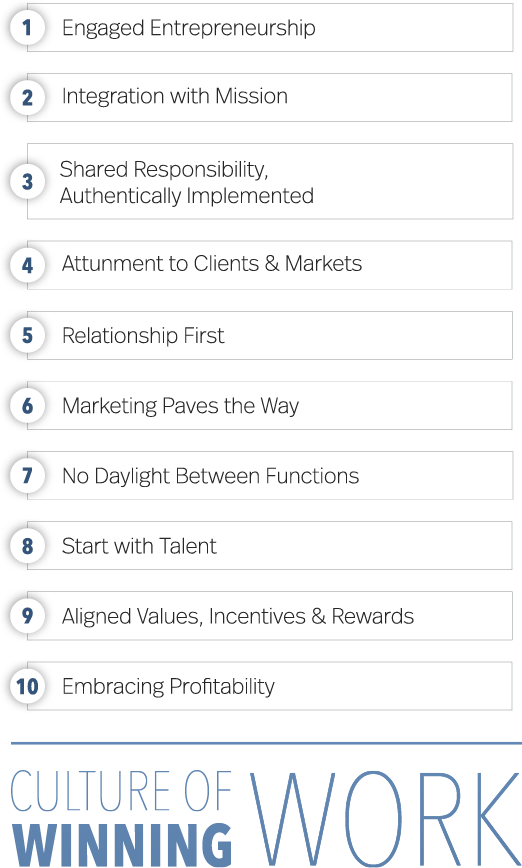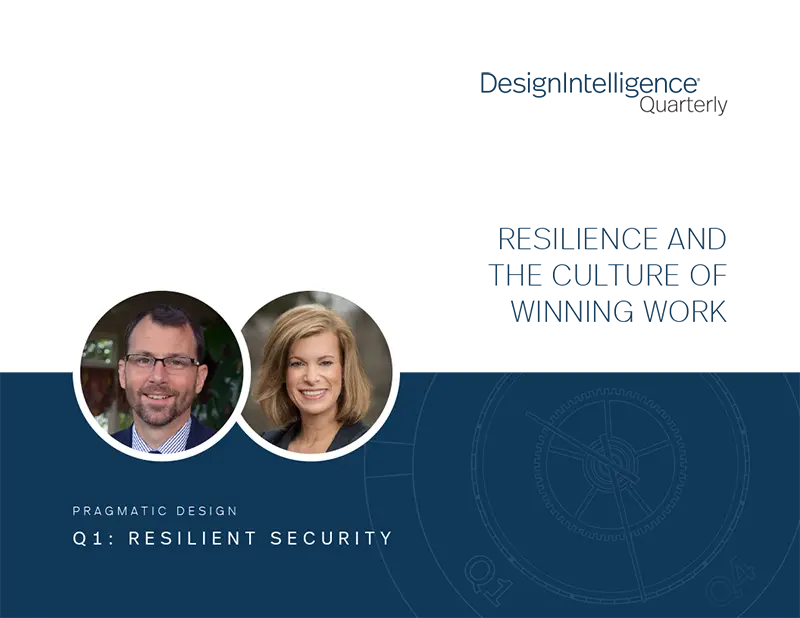Resilience and the Culture of Winning Work
by Bob Fisher
Principal, DesignIntelligence
& Phyllis Goetz
Principal, DesignIntelligence Strategic Advisory
March 15, 2023
DesignIntelligence’s Bob Fisher and Phyllis Goetz share key ideas for how firms can win the work they want from best-fit clients.
Leaders of professional service firms spend much of their days navigating the paradox of volatility, uncertainty and change. To succeed, they must balance building an enduring organization, which is helped by stability and predictability, with seizing opportunities created through rapid market shifts.
Turbulence is natural and unavoidable. Shocks and surprises will happen. Under such conditions, the ability to quickly adapt to change, recover from shocks and bounce back are a firm’s best bet to creating a sustainable enterprise. Resilience yields security.
But resilience is not only about performing well in moments of crisis. Much of what makes firms resilient is their inherent strength, just as a healthy body and immune system protect against illness. In the body of a professional services firm, the leader’s first job is to ensure the organization is robust enough to withstand what the world will likely throw at it.
Building a robust professional practice demands that firms not only deliver but also bring in work under a variety of conditions. The tradition of relying on a small number of rainmakers over-concentrates the firm’s revenue-generating power and leaves it vulnerable. Strategically distributing marketing and business development responsibilities across the firm ensures healthy redundancy. More importantly, it creates and perpetuates a culture of winning work. When everyone helps bring in work, synergy results and the process survives the failures or loss of any individual.
A firm’s culture has roots in its core values. The culture is shaped — and is shaped by — the structures, systems and policies of the businesses. Culture determines the unwritten rules that govern the ways employees see their practice and behave toward colleagues, clients, delivery partners and others. Culture is pervasive and its power is unmistakable.

Ten Qualities of a Winning Work Culture
What does a culture of winning work look like? While it appears different from firm to firm, it is characterized by ten qualities.
1. Engaged Entrepreneurship
The firm actively cultivates and rewards entrepreneurial mindsets and actions.
Since entrepreneurship can be articulated in many ways, how we define it is important. The concept is simple, but deep: Entrepreneurs see unmet needs in the market and create ways to fill the gaps.
True entrepreneurship involves a complex set of skills. They include an understanding the needs of the market empathetically, seeing opportunities that evaded others and inventing novel and profitable ways to help.
Entrepreneurial firms can tolerate reasonable, but elevated, levels of risk. They also understand the power of entrepreneurship to create opportunity for up-and-coming leaders, who are allowed the freedom and support to develop new service offerings, marketable intellectual property, office locations or market sectors.
2. Integration with Mission
People in the firm see winning work as part of a greater mission to help others and create great design.
Ask a hundred design or technical practitioners whether they are comfortable engaging in business development conversations, and you can expect only a few positive replies. Yet the same people can speak enthusiastically about how their work improves communities, organizations and the lives of individuals. Somehow, they don’t see those two conversations as fundamentally related.
In a true culture of winning work, leaders and staff see connecting with people before they are clients – i.e., in a business development context – as one of the first steps in understanding the client’s organization and figuring out how design might have a positive impact on them.
3. Shared Responsibility, Authentically Implemented
Everyone in the firm can tell you how they – in their role and style – help win projects.
No one wants to emulate the old stereotype of a door-to-door vacuum cleaner salesman: pushy, manipulative, self-serving and superficial. Obviously, there are exceptions among firms and individuals, but the ghost of this antiquated model still haunts the design professions.
In a culture of winning work, every member of the firm feels and accepts the responsibility of bringing in new clients and projects. It may be through efficient and thorough project management and communication or through excellent design work that exceeds expectations or by safeguarding the client’s interests during the construction administration process. No matter how a professional contributes or the level at which they do it, everyone plays a role in creating happy clients who can and will hire the firm again.
Three differences distinguish successful firms. The first is embracing responsibility. Professionals who practice within a culture of winning work own their contribution to keeping projects and clients coming in the door. The second is understanding that every role is important and helps win work. The third is authenticity. Everyone knows the most effective way to help bring in future business is to be honest and truthful about what they can and cannot provide.
4. Attunement to Clients and Markets
Everyone understands the value of what the firm offers, and many can spot opportunities because they understand the world in which clients live.
To client- and market-focused practitioners, clients are true collaborators and colleagues in creating great buildings and environments. Such practitioners pride themselves on serving clients well. In the process, they often develop meaningful personal relationships. The connections they form are natural, authentic aspects of the human experience both inside and outside professional life.
Though many understand their clients as people, fewer understand their clients’ professional worlds. That includes the ability to separate themselves from their roles as architects, designers or engineers and see the market through the eyes of the client. It also includes knowing how the client defines value. In a culture of winning work, team members have a greater degree of connection with the client and can articulate the value of their own work from the client’s perspective.
5. Relationships First and Foremost
Relationships trump projects in both business development and delivery.
One of the hallmarks of inauthenticity is a transactional attitude. The client is a warmly welcomed friend during a project or when there is the real possibility of a new one. Otherwise, they are simply not on the radar, or, worse, they are considered a waste of time. Conditional relationships tend to be superficial. They are rocky ground in which to try growing trust and loyalty.
In the culture of winning work, practitioners invest themselves personally and professionally with clients and think long-term. Their motivations are aligned with the client’s true needs. Great clients see it and reciprocate.

6. Marketing Paves the Way
Marketing is more than the RFP response – it’s the ongoing quest to create a unique place for the firm in the mind of the market.
In his book “Management,” strategy pioneer Peter Drucker famously said: “The aim of marketing is to make selling superfluous” by knowing and understanding the customer so well that the product or service sells itself. He continued: “Ideally, marketing should result in a customer who is ready to buy.”
In the traditional model of most design, architecture or engineering (AEC) firms, marketing’s role (and therefore aim) is far more limited. It exists primarily to respond to RFPs. It’s the job of business developers to identify and bring in clients who may choose the firm. Too often, not enough of the marketing department’s time and effort is devoted to proactively communicating about the firm and what it can do. The staff profile and budget of a firm’s marketing department provides ample evidence.
In Drucker’s view, and in the model used effectively in other industries (as well as a precious few AEC firms), marketing is more effective because it has a larger upfront role. Its job is to create influence – a unique place in the mind of the market – to position the firm and gain an advantage in the business development process. Firms that take that approach tend to have higher profiles and have more influential roles in the industry.
7. No Daylight Between Work-Winning Functions
Marketing and business development are parts of an integrated whole.
As described above, the traditional model of architecture, design and engineering makes marketing a support function within the business development process. Once marketing has a new emphasis and is staffed and provisioned for its new role, it no longer fits into the old system. As a result, the other business development-related components must also change.
The key is to view the entire process of winning work holistically, understanding that all functions of winning work (marketing, business development, sales) share the same basic functions: positioning the firm, understanding the needs of the market and clients and creating and advancing relationships. Top-tier firms design integrated systems that are tailored to their specific needs and approach.
8. Start with Talent
The culture of winning work informs the search for all types and levels of talent.
Firms seek people who provide needed skills, have the right attitude and fit into the team. The fundamentals of that approach do not change in the culture of winning work, but the criteria will.
New practitioners get little or no exposure to the business of architecture, design and engineering in their training or early years of practice. More seasoned professionals carry baggage from their previous firm cultures, good or bad. Each group provides its own challenges in finding a match for the culture of winning work.
The concept is simple: Look for people with the right attitudes and dispositions. Pay attention to how candidates think about and articulate their roles and their impact on clients. Candidates must be able to see their roles as part of the essential cycle of winning work and be predisposed to own the responsibility.
9. Aligned Incentives, Values and Rewards
The firm’s systems and policies align with its values, reward desired behaviors and contribute positively to its culture.
Hard aspects like systems, processes and policies have a reciprocal relationship with the softer cultural side. Each shapes the other. How you reward people for winning work can foster collaboration or drive competition. So too can the way in which the firm defines profit centers and their relationship to performance bonuses. There are many valid approaches. Each involves trade-offs. An essential part of shaping culture is putting policies in place that support the ways of thinking, speaking and behaving you wish to see, based on your firm’s vision and goals.
Designing a culture of winning work includes simple incentives that reward the behavior the firm desires. Incentives can focus on individual work but should also involve team or companywide goals to foster collaboration. Incentives should be designed with revenue and profitability goals in mind.
10. Embracing Profitability
The firm prioritizes resources for its purpose and future.
Our DesignIntelligence colleague Scott Simpson often says that too many firms see profit as what is left over at the end of the job. The attitude is passive. It fails to recognize the power of profit to facilitate the firm’s purpose and the joys of practicing at the highest level. As Irene Kraus, the Roman Catholic nun who led the Daughters of Charity National Health System, famously said, “No margin, no mission.”

A healthy attitude toward profitability can transform how the firm creates efficiencies without sacrificing quality, how it manages projects and how it structures and negotiates deals.
Profitable firms have the resources to do what they love. They can invest in talent, new ventures, technology and building design capability. They have the freedom to experiment because they have the financial security to take risks. Money is rarely the chief motivator for architects and designers, though it can allow firms and individuals to reach the aspirations that originally led them into the profession.
Many characteristics of the culture of winning work have to do with attitude or mindset. They are the foundation of perspective, which frames the way one looks at building culture and business systems. Establishing the right mindset is essential, but work must not stop there. Building culture involves changing deeply seated ideas, beliefs, and behaviors. Fostering such change requires continuous effort, but the benefits are equally foundational: a long-term sustainable winning culture and resilience coupled with profitability. All that leads to financial security and the ability to grow and do the firm’s best work for great clients – and the potential for ever-increasing positive impact.
Bob Fisher is a principal with DesignIntelligence. In addition to 10 years focusing on the built environment industry,
he has 20 years’ additional brand and marketing experience with sectors as diverse as entertainment, technology, manufacturing and
education.
Phyllis Goetz is a principal with DesignIntelligence Strategic Advisory and a lead instructor in the DesignIntelligence Learning
Institute. Phyllis has over 40 years of experience in driving profitable growth, is the former president of Kimball and the founder of
Nurture, Steelcase’s Healthcare Division.

 Bob Fisher
Bob Fisher
 Phyllis Goetz
Phyllis Goetz
